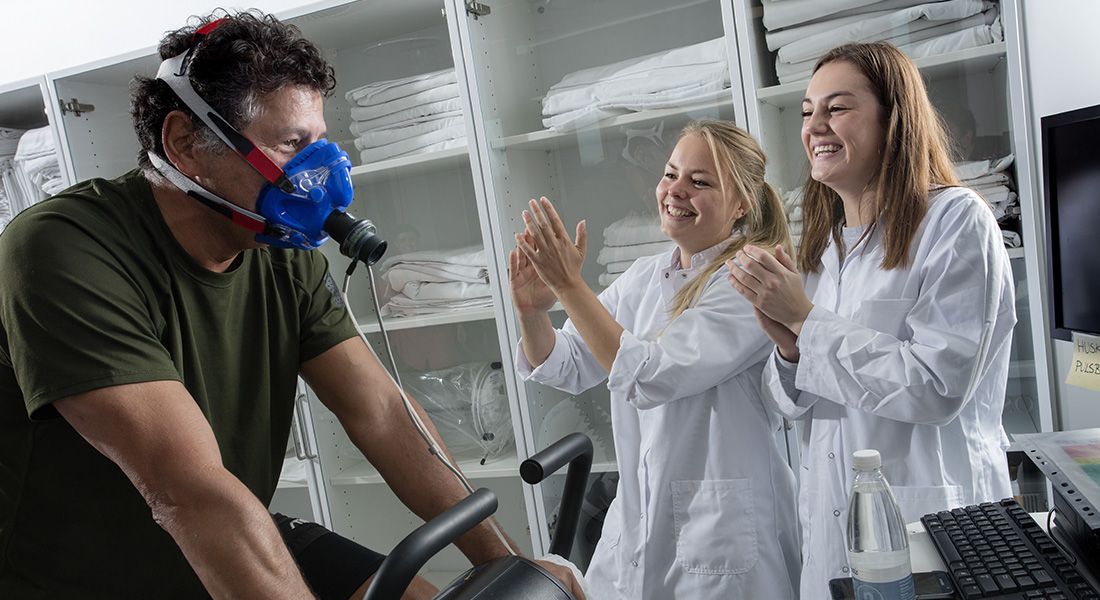Exercise and metabolism in Xlab
Our research is based on Human Exercise Physiology & Metabolism - in Health and Disease. Our goal is to fully understand the mechanisms behind at all levels; from whole body to intracellular.

Our group performs human studies to unravel the effects of exercise and physical training on metabolic health, and cardiovascular regulation in different populations. We design and run clinical and lifestyle interventions. Our laboratory is unique as it hosts an extensive range of expertise; clinical and human physiology, metabolic and cardiovascular research, histology and cell biology, biochemistry and molecular biology. We are continuously optimizing and standardizing methods to assess fitness, metabolic health, biological age, tissue pathology, mitochondria bioenergetics and function, quantitative and qualitative alterations of intracellular energy stores and organelles.
- Skeletal muscle mitochondrial respiratory capacity is dissociated from insulin resistance. Long-term studies in patients with type 2 diabetes undergoing gastric by-pass surgery showed that while insulin sensitivity increased markedly over an almost 2 yr. period following surgery, mitochondrial respiration remained stable and unchanged (Lund et al. Acta Physiologica, 2018).
- High Intensity Interval Training (HITT) is an effective training modality for patients with insulin resistance. It requires a minimum of time commitment, and yields similar improvements as strength and endurance training. However, the intensity is high as the modality may not be intuitively attractive for obese people with diabetes (Dela et al. Acta Physiologica, submitted).
- Metabolism at the cellular level is regulated by intracellular compartmentalization of reactions and processes. The quality and organization of intracellular energy stores and mitochondrial networks are impaired with physical inactivity and obesity.
- Statin treatment is used to lower cholesterol, but some side-effects are seen primarily muscle pain, which can be associated with mitochondrial function. We found that mitochondrial intrinsic respiratory capacity is increased in statin treated patients experiencing muscle pain (Dohlmann et al., JCEM, 2018).
Physical Training and Pharmacological Treatment of Type 2 Diabetes mellitus
PhD study commencing medio 2019. Arthur Ingersen, MD. Aims: In T2DM to investigate the effects of aerobic training on pancreatic β-cell function, secretory capacity and bone quality; to compare the effects of strength training and aerobic training on pancreatic β-cell secretory capacity and bone quality; and to investigate the effects of noradrenaline infusion on β-cell function and secretory capacity.
Biological Age estimation is frequently used as a health tool
In this project, we investigate the use of Biological Age technology and explore how reliable this health technology is to induce favorable changes in metabolic risk factors. This is done with three separate projects, where biological age is evaluated after 1 year in free-living subjects 1 year after, where a cross-sectional approach is used to study the estimation algorithm and finally a validation experiment.
Link between mitochondrial dynamics and function
The role of mitochondrial dynamics as a regulator of organelle function will be investigated in human biopsies and cell cultures, combining nanoscale microscopy with high resolution respirometry.
Antioxidants and mitochondrial function
Insulin resistance and type 2 diabetes are linked to increased production of reactive oxygen species from skeletal muscle mitochondria. Whether supplementation with antioxidants (glutathione) can prevent this, is investigated in patients with type 2 diabetes and matched control participants.
Group leaders

Jørn Wulff Helge
Professor
Mail: jhelge@sund.ku.dk
Mobile: +45 28 75 75 06

Mail: fdela@sund.ku.dk
Mobile: +45 21 20 99 57

Steen Larsen
Associate professor
Mail: stelar@sund.ku.dk
Mobile: +45 21 15 19 24
Forskere/gruppemedlemmer
Interne
| Name | Title | Job responsibilities | Phone | |
|---|---|---|---|---|
| Clara Prats Gavalda | Associate Professor | CFIM LM | +4535330706 | |
| Elisabeth Ann Bandak | Postdoc | Human Movement Science | ||
| Elise Gerlach Melhedegaard | Research Assistant | Ochala Group | +4529459686 | |
| Flemming Dela | Professor | Dela Group | +4535327425 | |
| Julien Ochala | Associate Professor - Promotion Programme | Ochala Group | +4535335651 | |
| Jørn Wulff Helge | Professor | Helge Group | ||
| Linn Gillberg | Assistant Professor | Xlab | ||
| Mikkel Thunestvedt Hansen | PhD Fellow | Helge Group | +4535334422 | |
| Steen Larsen | Associate Professor | Larsen Group | ||
| Thomas Nyegaard Beck | Biomedical Laboratory Scientist | Ochala Group | ||
| Tine Alkjær | Associate Professor | Human Movement Science |
